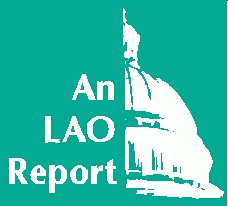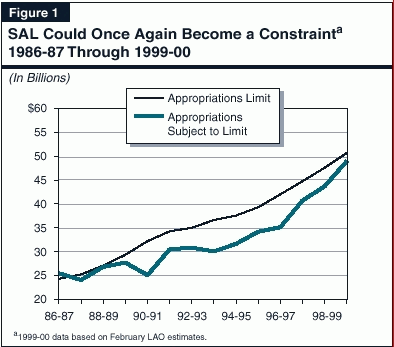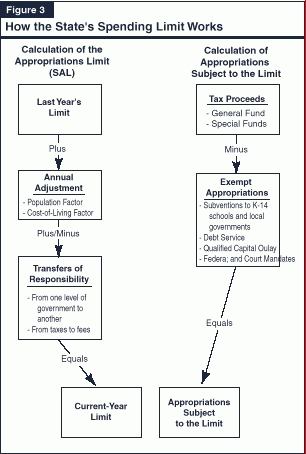
 |
The State
|
Background |
California's state appropriations limit (SAL)--originally established by Proposition 4 in 1979--places an "upper bound" each year on the
amount of monies that can be spent from state tax proceeds. The SAL itself grows annually by a population and cost-of-living factor.
Most state appropriations are subject to the SAL. However, the law does exempt certain types of appropriations from the SAL, including capital outlay, local government subventions, and debt service. Tax proceeds in excess of the SAL over a two-year period must be equally split between rebates to taxpayers and expenditures on education. The SAL has not been a constraint throughout the 1990s. In recent years, however, California's strong revenue performance has caused the "room" under the limit to shrink. | |
LAO Findings |
The 2000-01 Governor's Budget introduced in January, estimated the room under the limit to be nearly $3.8 billion in 1999-00 and
$4 billion in 2000-01. However, if current revenue trends continue, these margins could disappear.
Thus, the SAL could become a factor in the Legislature's budgetary deliberations as early as this spring, when decisions are made about both the current and budget years. | |
Legislative Considerations |
Given recent revenue trends and their potential implications for the SAL, it is important that the Legislature begin considering what policy
steps, if any, should be taken if the SAL indeed becomes a constraint.
The available options could include one or a combination of the following:
|
After having been on the "back burner" for more than a decade, the state appropriations limit (SAL) could once again become an issue this spring in the Legislature's budget-related deliberations. This is because the extraordinary revenue increases currently being experienced, if sustained, could result in the spending limit becoming a fiscal constraint in 1999-00 and/or 2000-01.
Given the emergence of this situation, it is important that the Legislature re-familiarize itself with what the SAL is, how it works, and the policy options that are available should the limit be reached. This report discusses these issues, along with the budget-related considerations that will face the Legislature should it have to deal with the limit.
When California's voters approved Proposition 4 on the November 1979 special election ballot, the SAL was established in Article XIII B of the State Constitution. (The SAL is sometimes referred to as the "Gann Limit," in reference to one of the author's of Proposition 4.) The SAL has been modified by two subsequent initiatives--Proposition 98 in 1988 and Proposition 111 in 1990--but its basic framework remains in place today.
Article XIII B does three key things. Specifically, it:
No Initial Effect. At the state level, the appropriations limit was not much of a factor during the early years following its enactment. This is because in the early 1980s the combination of high inflation and weak revenue growth during the 1980 through 1982 recession caused a large amount of room under the limit to open up.
Limit Was Exceeded in 1986-87. After several years of strong revenue growth, though, the limit became a constraint in the second half of the decade. In fact, the state exceeded its limit in 1986-87. This resulted in a $1.1 billion taxpayer rebate in the following year.
Plenty of Excess Room Existed in the 1990s. As indicated in Figure 1, state appropriations again fell below the limit in subsequent years, and the room under the SAL became very large in the early 1990s. This occurred when the combination of voter-approved changes to the way the limit is calculated (see below) and California's severe economic recession caused the gap between the SAL and appropriations subject to the limit to reach nearly $7 billion.

Little, If Any Room, Exists Today. As discussed below, however, exceptionally strong revenue growth in recent years has caused the room under the limit to erode considerably. For example, based on our February 2000 estimates, the gap had shrunk to $1.8 billion in the current year. Since our February projections, revenues have continued to soar above expectations. If the current positive revenue trends continue, the remaining $1.8 billion current-year gap would be eliminated.
Some significant modifications have been made to the limit since it was first approved by the voters in 1979. For example, appropriations funded by new tobacco taxes enacted through Proposition 99 (1988) and Proposition 10 (1998) were designated as exempt appropriations, and thus, not subject to the SAL. More significant changes occurred when voters approved Proposition 98 in 1988, and Proposition 111 in 1990. Figure 2 (see page 4) shows how key provisions of the original spending limit were affected by these two propositions.
| Figure 2 | ||||
| Article XIII B: Changes Made by Propositions 98 and 111 | ||||
| Type of Provision | Original Provisions in Proposition 4 | Changes Made by: | ||
| Proposition 98 | Proposition 111 | |||
| Annual Adjustments to Spending Limit | Statewide population growth plus lesser of U.S. CPI or California per-capita personal income growth. | No changes. |
| |
| ||||
| Exempt Appropriations | Includes subventions, debt service, retirement costs, and unemployment insurance compensation. | No changes. |
| |
| Allocation of Excess Revenues | Returned to taxpayers in the following year. | First portion to Proposition 98 (up to 4 percent of the minimum guarantee), with remainder to taxpayers. |
| |
| ||||
Proposition 98. Prior to the passage of Proposition 98, Article XIII B had required that 100 percent of excess revenues be rebated to taxpayers. Proposition 98 instead specified that the first portion of excess revenues be allocated to schools, up to 4 percent of the minimum funding guarantee. Excess revenues above the 4 percent level (equal to about $400 million in 1988) continued to be rebated to taxpayers.
Proposition 111. In addition to imposing additional taxes on gasoline and modifying Proposition 98's minimum funding formulas, Proposition 111 made several significant changes to the SAL. Chief among these were its changes to (1) the SAL's annual inflation and population adjustment factors, and (2) how excess revenues are to be calculated and allocated among school spending and taxpayer rebates.
Each year, both the state and each of its local governmental jurisdictions are required to calculate their own spending limits and their appropriations that are subject to their limits. The process for the state's limit (the SAL) is outlined in Figure 3.

The calculation of the SAL for any given year is accomplished by first taking the SAL for the previous year and adjusting it for the population and cost-of-living factors described above. The limit is also adjusted in the event that there is a transfer of financial responsibility for a specific program between the state and another level of government. (In this case, any increase in the state's limit would need to be offset by a corresponding decrease in the other entity's limit, and vice versa.) The limit is also decreased for transfers of financial responsibility for funding of a specific program from taxes to fees or other nontax proceeds.
In general, these represent all appropriations funded from the proceeds of taxes, except appropriations for purposes specifically exempted under Article XIII B.
Proceeds of Taxes. Article XIII B defines proceeds of taxes to include (1) tax revenues, (2) investment earnings on tax proceeds, and (3) fees and charges in excess of the cost of providing the specific service for which they are intended and/or imposed. Appropriations financed by other forms of revenues--such as charges, licenses, fees, proceeds of asset sales, and settlement funds--are not subject to the limit.
Exempt Appropriations. As noted above, basically all appropriations of tax proceeds are subject to the limit except for those specifically exempted under Article XIII B. Exempt appropriations include debt service, qualified capital outlay, mandates, retirement and unemployment insurance payments, and subventions to other levels of governments (the later of which are counted against the recipient entities spending limits). Examples of subventions exempt from the SAL include K-12 and community college spending for general apportionments, and taxes that are collected by the state but then allocated to local governments for locally determined purposes. The latter includes amounts to backfill local vehicle license fee (VLF) revenue losses due to the recent VLF rate reductions.
A significant issue concerning the current fiscal outlook involves how budgetary reserve funds are treated under the SAL. Article XIII B specifies that appropriations to reserve funds (including the Special Fund for Economic Uncertainties, or SFEU) represent appropriations subject to the limit in the year in which they are made. In practical terms, this means that all revenues received in a given year are counted toward that year's limit, unless they are appropriated for exempt purposes. This includes unanticipated receipts that end up in the SFEU at year end, since under existing state law these "unused" revenues are automatically appropriated to the SFEU.
Correspondingly, appropriations from the reserve are exempt from the limit. In the context of the current budget situation, this means that appropriations from this year's accumulated reserve would not count against next year's limit.
How Are They Established? As a result of the changes enacted by Proposition 111 in 1990, "excess revenues" are established over a two-year period. Specifically, the combination of revenues in any given fiscal year and the subsequent fiscal year that are in excess of the SAL during the same two respective years, are considered excess revenues. As an illustration, if state appropriations subject to the SAL were to exceed the limit by $100 million this year but fall below next year's SAL by an equal $100 million, there would be zero excess revenues. Alternatively, if the state were to exceed its limit by $100 million in both this year and next year, it would have $200 million of excess revenues at the end of this two-year cycle.
How Are Excess Revenues Then Allocated? Any excess revenues are to be divided equally between Proposition 98 spending and taxpayer rebates. The 50 percent going to schools would be allocated between K-12 and community colleges in proportion to their enrollments. Any excess revenues going to schools would not increase the base when computing the Proposition 98 minimum funding guarantee in future years. The 50 percent going for taxpayer rebates would be rebated during the following two fiscal years.
As indicated earlier, recent revenue growth has eroded most of the room under the limit, and revenues could exceed the SAL as early as in the current year if the extraordinary current economic and revenue trends continue. As an indication of how quickly the erosion has been occurring, consider that as recently as January, when the 2000-01 Governor's Budget was released, the Department of Finance estimated that the room under the limit was nearly $3.8 billion for 1999-00 and $4 billion for 2000-01. By mid-February, however, due to booming tax receipts, we issued revenue projections that were $2.1 billion above the Governor's for each year, bringing down the room under the SAL to roughly $2 billion in each year. Since then, revenues have substantially exceeded our own expectations. Should these current revenue trends continue during the remaining three months of the current year, full-year revenues could reach or exceed the SAL for 1999-00.
If revenues continue booming and the state were to find itself above the SAL, the Legislature would be faced with several basic options.
In evaluating these policy options, it is important to remember that because Article XIII B counts additions to the reserve as appropriations subject to limitation, unallocated state revenues will automatically count against the state's spending limit. Thus, the Legislature does not have the option of simply letting excess revenues flow into the SFEU.
What About Timing Considerations? The Legislature will also need to be aware of various timing considerations. For example:
Given that one of the key SAL-related legislative policy options would be to increase local subventions, an important consideration is the extent to which such localities as schools, cities, counties, and special districts have room to absorb additional subventions without exceeding their own appropriations limits.
Schools. Under existing law, the state counts as much of its general apportionments as will fit into school districts limits, with any remaining state funding counting towards the state limit. Our review of State Department of Education data indicates that most districts are at their limits. Thus, there appears to be little room at the school district level to absorb additional state spending within their limits.
Other Local Entities. With regard to nonschool local entities (that is, cities, counties, and special districts), however, there is considerable room available. There are a few examples of local entities that have reached or exceeded their limits during the past two decades. However, the appropriations of most cities and counties are generally only 40 percent to 80 percent of their respective limits.
Following several years of extraordinarily strong revenue growth, the amount of room under the SAL has dramatically decreased. In fact, if recent revenue trends continue and booming tax collections continue to exceed expectations, the SAL could be reached within the very near future--possibly as early as this year. Given this, it is important that the Legislature re-familiarize itself with the SAL's provisions and the various policy options available for responding to it. This will ensure that if the SAL is in fact reached, the state's response will effectively take account of the Legislature's taxation and spending priorities, including priorities in such areas as education, infrastructure, and local government fiscal relief.
| Acknowledgments
This report was prepared by Brad Williams and David Vasché, with the assistance of others throughout the office. The Legislative Analyst's Office (LAO) is a nonpartisan office which provides fiscal and policy information and advice to the Legislature. |
LAO Publications
To request publications call (916) 445-2375. This report and others, as well as an E-mail subscription service, are available on the LAO's Internet site at www.lao.ca.gov. The LAO is located at 925 L Street, Suite 1000, Sacramento, CA 95814. |